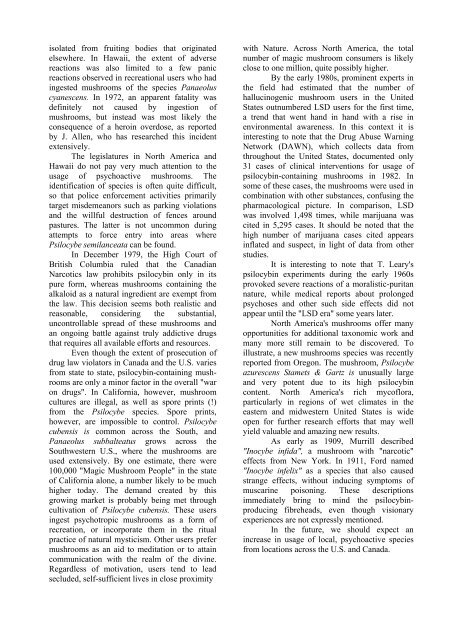Jochen Gartz - Magic Mushrooms Around the ... - preterhuman.net
Jochen Gartz - Magic Mushrooms Around the ... - preterhuman.net
Jochen Gartz - Magic Mushrooms Around the ... - preterhuman.net
Create successful ePaper yourself
Turn your PDF publications into a flip-book with our unique Google optimized e-Paper software.
isolated from fruiting bodies that originated<br />
elsewhere. In Hawaii, <strong>the</strong> extent of adverse<br />
reactions was also limited to a few panic<br />
reactions observed in recreational users who had<br />
ingested mushrooms of <strong>the</strong> species Panaeolus<br />
cyanescens. In 1972, an apparent fatality was<br />
definitely not caused by ingestion of<br />
mushrooms, but instead was most likely <strong>the</strong><br />
consequence of a heroin overdose, as reported<br />
by J. Allen, who has researched this incident<br />
extensively.<br />
The legislatures in North America and<br />
Hawaii do not pay very much attention to <strong>the</strong><br />
usage of psychoactive mushrooms. The<br />
identification of species is often quite difficult,<br />
so that police enforcement activities primarily<br />
target misdemeanors such as parking violations<br />
and <strong>the</strong> willful destruction of fences around<br />
pastures. The latter is not uncommon during<br />
attempts to force entry into areas where<br />
Psilocybe semilanceata can be found.<br />
In December 1979, <strong>the</strong> High Court of<br />
British Columbia ruled that <strong>the</strong> Canadian<br />
Narcotics law prohibits psilocybin only in its<br />
pure form, whereas mushrooms containing <strong>the</strong><br />
alkaloid as a natural ingredient are exempt from<br />
<strong>the</strong> law. This decision seems both realistic and<br />
reasonable, considering <strong>the</strong> substantial,<br />
uncontrollable spread of <strong>the</strong>se mushrooms and<br />
an ongoing battle against truly addictive drugs<br />
that requires all available efforts and resources.<br />
Even though <strong>the</strong> extent of prosecution of<br />
drug law violators in Canada and <strong>the</strong> U.S. varies<br />
from state to state, psilocybin-containing mushrooms<br />
are only a minor factor in <strong>the</strong> overall "war<br />
on drugs". In California, however, mushroom<br />
cultures are illegal, as well as spore prints (!)<br />
from <strong>the</strong> Psilocybe species. Spore prints,<br />
however, are impossible to control. Psilocybe<br />
cubensis is common across <strong>the</strong> South, and<br />
Panaeolus subbalteatus grows across <strong>the</strong><br />
Southwestern U.S., where <strong>the</strong> mushrooms are<br />
used extensively. By one estimate, <strong>the</strong>re were<br />
100,000 "<strong>Magic</strong> Mushroom People" in <strong>the</strong> state<br />
of California alone, a number likely to be much<br />
higher today. The demand created by this<br />
growing market is probably being met through<br />
cultivation of Psilocybe cubensis. These users<br />
ingest psychotropic mushrooms as a form of<br />
recreation, or incorporate <strong>the</strong>m in <strong>the</strong> ritual<br />
practice of natural mysticism. O<strong>the</strong>r users prefer<br />
mushrooms as an aid to meditation or to attain<br />
communication with <strong>the</strong> realm of <strong>the</strong> divine.<br />
Regardless of motivation, users tend to lead<br />
secluded, self-sufficient lives in close proximity<br />
with Nature. Across North America, <strong>the</strong> total<br />
number of magic mushroom consumers is likely<br />
close to one million, quite possibly higher.<br />
By <strong>the</strong> early 1980s, prominent experts in<br />
<strong>the</strong> field had estimated that <strong>the</strong> number of<br />
hallucinogenic mushroom users in <strong>the</strong> United<br />
States outnumbered LSD users for <strong>the</strong> first time,<br />
a trend that went hand in hand with a rise in<br />
environmental awareness. In this context it is<br />
interesting to note that <strong>the</strong> Drug Abuse Warning<br />
Network (DAWN), which collects data from<br />
throughout <strong>the</strong> United States, documented only<br />
31 cases of clinical interventions for usage of<br />
psilocybin-containing mushrooms in 1982. In<br />
some of <strong>the</strong>se cases, <strong>the</strong> mushrooms were used in<br />
combination with o<strong>the</strong>r substances, confusing <strong>the</strong><br />
pharmacological picture. In comparison, LSD<br />
was involved 1,498 times, while marijuana was<br />
cited in 5,295 cases. It should be noted that <strong>the</strong><br />
high number of marijuana cases cited appears<br />
inflated and suspect, in light of data from o<strong>the</strong>r<br />
studies.<br />
It is interesting to note that T. Leary's<br />
psilocybin experiments during <strong>the</strong> early 1960s<br />
provoked severe reactions of a moralistic-puritan<br />
nature, while medical reports about prolonged<br />
psychoses and o<strong>the</strong>r such side effects did not<br />
appear until <strong>the</strong> "LSD era" some years later.<br />
North America's mushrooms offer many<br />
opportunities for additional taxonomic work and<br />
many more still remain to be discovered. To<br />
illustrate, a new mushrooms species was recently<br />
reported from Oregon. The mushroom, Psilocybe<br />
azurescens Stamets & <strong>Gartz</strong> is unusually large<br />
and very potent due to its high psilocybin<br />
content. North America's rich mycoflora,<br />
particularly in regions of wet climates in <strong>the</strong><br />
eastern and midwestern United States is wide<br />
open for fur<strong>the</strong>r research efforts that may well<br />
yield valuable and amazing new results.<br />
As early as 1909, Murrill described<br />
"Inocybe infida", a mushroom with "narcotic"<br />
effects from New York. In 1911, Ford named<br />
"Inocybe infelix" as a species that also caused<br />
strange effects, without inducing symptoms of<br />
muscarine poisoning. These descriptions<br />
immediately bring to mind <strong>the</strong> psilocybinproducing<br />
fibreheads, even though visionary<br />
experiences are not expressly mentioned.<br />
In <strong>the</strong> future, we should expect an<br />
increase in usage of local, psychoactive species<br />
from locations across <strong>the</strong> U.S. and Canada.








![The Big Lie 9-11 and Government Complicity in Mass Murder [PDF]](https://img.yumpu.com/50957077/1/190x245/the-big-lie-9-11-and-government-complicity-in-mass-murder-pdf.jpg?quality=85)








